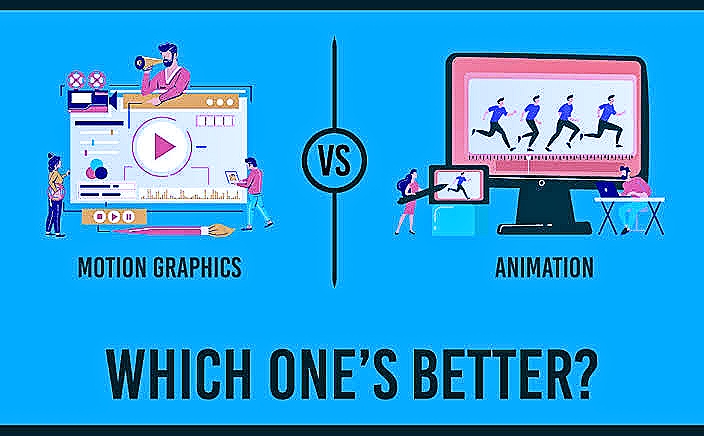Motion Graphics vs. Animation: What’s the Difference?
You’ve probably seen both of these everywhere—from the ads on your social media feeds to the cartoons you might binge-watch on a lazy Sunday. But when we get down to it, what sets them apart? And more importantly, why should you care?
Think of this as entering a magical world where images and characters don’t just sit still; they dance, tell stories, and sometimes, even sell you stuff without you realizing it. In one corner, we have motion graphics, the sleek and stylish way to present facts, figures, and ideas that might otherwise make your eyes glaze over. In the other corner, we have Animation—the heart and soul behind countless characters and stories that have probably made you laugh, cry, or even change your perspective on life.
Why does this matter, especially if you want to tell your story or market a product? Knowing the strengths and powers of each can help you choose the right one for your project, making your message heard, felt, and remembered. So why wait? We are going to cover everything in this blog. Without further delay, let’s dive into it.
Let’s Start With The Basic First
Motion Graphics
What are motion graphics?
Alright, let’s talk about motion graphics first! Imagine you’re flipping through your favourite social media app and coming across excellent, animated graphics that pop up in ads, explainers, or even your friends’ stories. Those are motion graphics! Motion graphics are pieces of Animation or digital footage that create the illusion of motion or rotation. They’re often combined with audio for use in multimedia projects.
Think of motion graphics as a way to bring graphic design to life. A motion graphic could be even more if a picture is worth a thousand words. They can make complex ideas easier to understand, like visualizing data in an info graphic or explaining how something works in a fun, engaging way. It’s like adding a superpower to static images, making them move, dance, or tell a story. They appear everywhere – in commercials, movies, apps, and websites. So, the next time you see a graphic start to move and tell a story on your screen, you’ll know that it’s motion graphics in action!
The role of motion graphics in modern media
Motion graphics are like the fantastic, flashy elements you see in videos, ads, and apps. Think of them as animated designs that combine text, images, and sometimes cool sound effects to grab your attention or explain something in a fun way. They’re everywhere in modern media because they’re so good at making information catchy and engaging.
So, when you’re scrolling through social media and see an animated infographic explaining something like climate change or a new tech gadget, that’s motion graphics in action. They’re used to tell stories, advertise products, and make complex information more accessible to digest. It’s like adding spices to a dish; motion graphics spice up content to make it more exciting and memorable.
In today’s world, where everyone’s competing for your attention, motion graphics are super important. They help messages stand out in a sea of information. Whether it’s a quick animation in a YouTube video, a sleek intro to a news segment, or an interactive chart on a website, motion graphics play a huge role in how we consume and enjoy media today. They’re not just about looking good; they help us better understand and connect with the content.
Now Let’s Talk About Animation
What is actually Animation?
Animation is like bringing drawings or models to life! Imagine you have a flipbook where each page has a drawing. When you flip through the pages quickly, the drawings move. That’s the basic idea behind Animation, but nowadays, we use computers to make even more astonishing animations, like the cartoons you watch on TV or those fantastic 3D movies.
So, Animation is the process of creating the illusion of motion by showing a series of pictures or frames in rapid succession. Each image is slightly different from the one before, making it look like the characters or objects are moving independently. Animators can work with everything from hand-drawn pictures to complex computer models to create these moving images. It’s a way to tell stories, express ideas, or create something fun and entertaining. Whether it’s a superhero saving the day, a talking car, or a funny slice of bread dancing, Animation brings these characters and stories to life uniquely and engagingly! Want to know the history of Animation? Check out this complete guide to Animation.
Simply, Animation is more expensive. Motion graphics are usually easier to produce. It’s a less complex form of Animation. But when you start looking at photorealistic CGI, hand-drawn or painted artwork, and stop-motion techniques, expect to invest more money.
Motion graphics vs. Animation: When to use each technique
Now, let’s understand the difference between motion graphics and Animation and when it’s best to use each technique. Imagine these two as cousins in the big family of visual storytelling, each with their strengths and occasions where they shine the brightest.
When to use Motion Graphics:
Think of motion graphics as graphic design that’s taken a fun potion and started moving around. It’s all about bringing text, shapes, and simple illustrations to life in a way that grabs your attention. You’ve probably seen motion graphics in action with animated logos, stylish explainer videos, or those super engaging info graphics that keep you scrolling. It’s best used when you want to convey information or communicate ideas, data, or concepts visually engagingly. It’s perfect for business presentations, educational content, or promotional videos that aim to inform and impress without a complex narrative or characters.
When To Use Animation:
Animation is the broader term that covers a whole spectrum of techniques, including motion graphics. But when we talk about Animation in contrast to motion graphics, we often think about character or story-driven pieces. This is where the magic of cartoons, movies, or any content with a narrative unfolds. Animation breathes life into characters, builds worlds, and takes the audience on a journey. It’s perfect for telling stories, whether heartwarming, funny, educational, or anything. If your goal is to connect emotionally with your audience or to narrate a tale that entertains or educates, then Animation is your best bet.
Bonus animation techniques for you
Think of Animation as the art of bringing drawings or models to life, making them move and express emotions just like we do. Here are five excellent techniques animators use:
Squash and Stretch: This is about making objects feel flexible and alive. Imagine a ball bouncing. When it hits the ground, it squashes flat for a split second before stretching out as it bounces back up. This technique gives objects weight and elasticity, making them seem more real and lively.
Anticipation: There’s a small, opposite action before any significant movement. Like, if you’re going to jump up, first you crouch down. This helps viewers prepare for what’s happening, making the Animation feel more natural. It’s like a visual heads-up!
Follow Through and Overlapping Action: These are about realism in motion. When a character stops running, not every part of them stops at once. Their hair or clothes might keep moving a bit before settling down. Similarly, when driving, different parts might begin at slightly different times. This technique adds fluidity and realism to movements.
Secondary Action: This adds extra details to the main action to enhance realism and give depth to the characters. For example, when someone walks, their arms swing, and maybe their hair bounces. These small actions aren’t the main focus but add life and believability to the scene.
Arcs: Most natural movements follow a curved path or arc. When animating, using arcs makes motion look smoother and more natural. Whether it’s an arm swing or a character’s leap, moving along an arc adds realism.
Which one is best for Marketing?
Well, it really depends on your message and goals. Motion graphics might be your best bet if you need to simplify complex information or data. They’re clean, professional, and get straight to the point. But if you aim to tell a story that tugs at the heartstrings or takes your audience on a journey, Animation could be the winner, offering that deep emotional connection.
Think about what you want to achieve and the story you want to tell. Both motion graphics and Animation have superpowers in the marketing world; choosing the right one depends on the unique flavour you wish to bring to your audience.
Need help? Which one to choose for your marketing?
We’re here to help you get it right. Want to know more? Get in touch with any queries you have. We will be happy to help you out.

